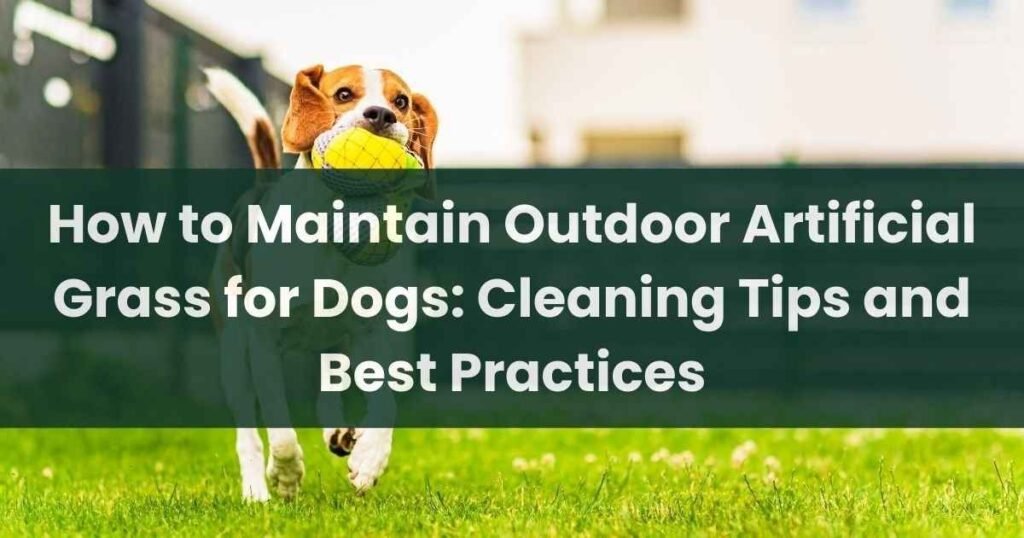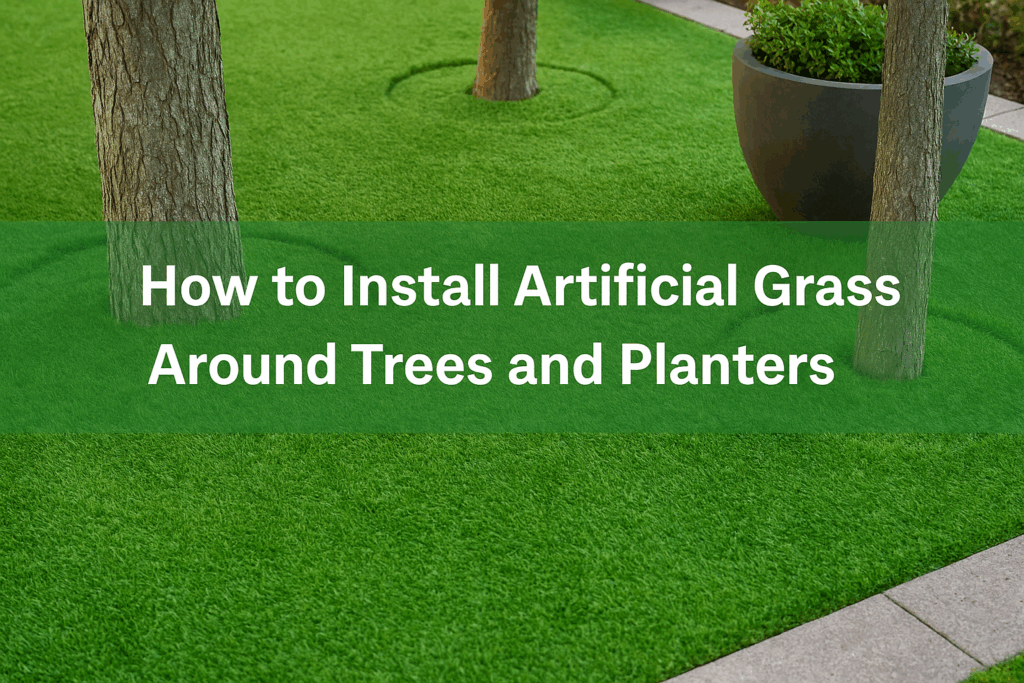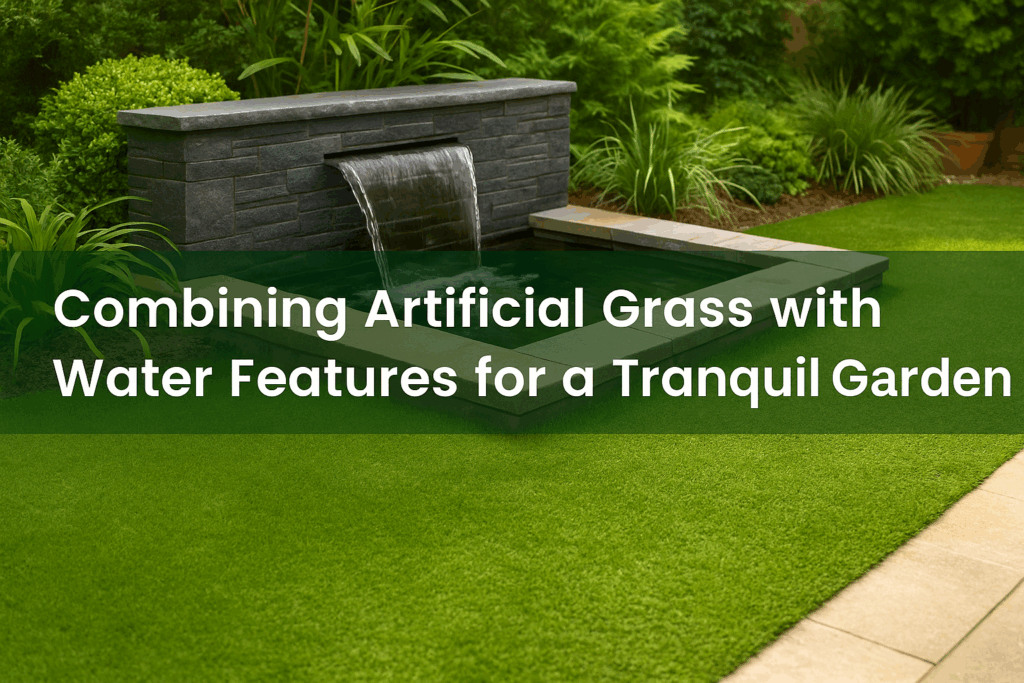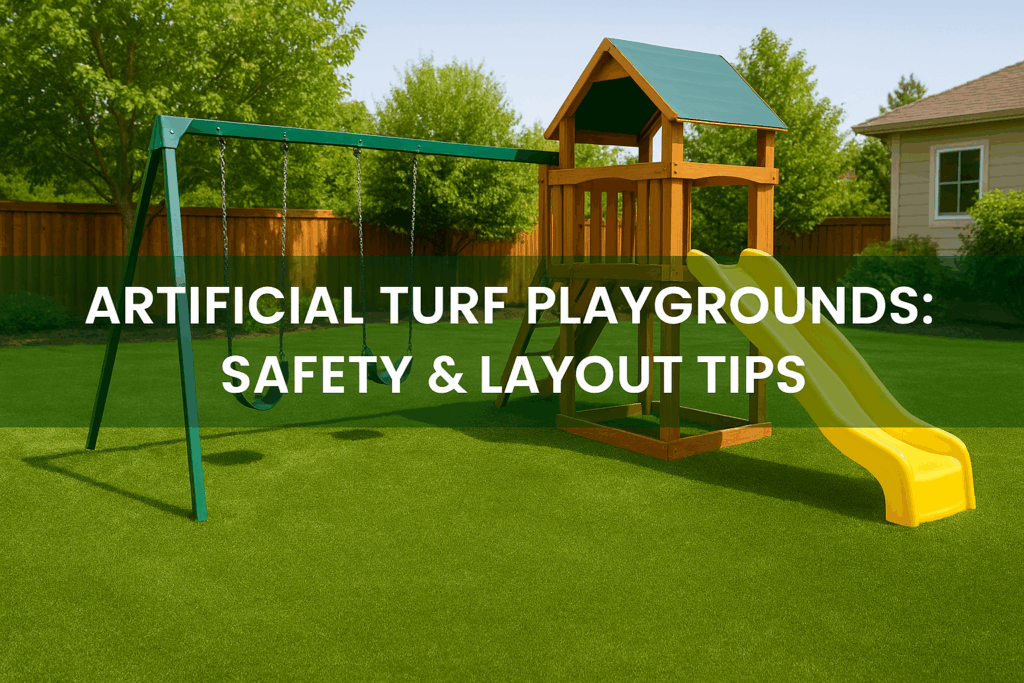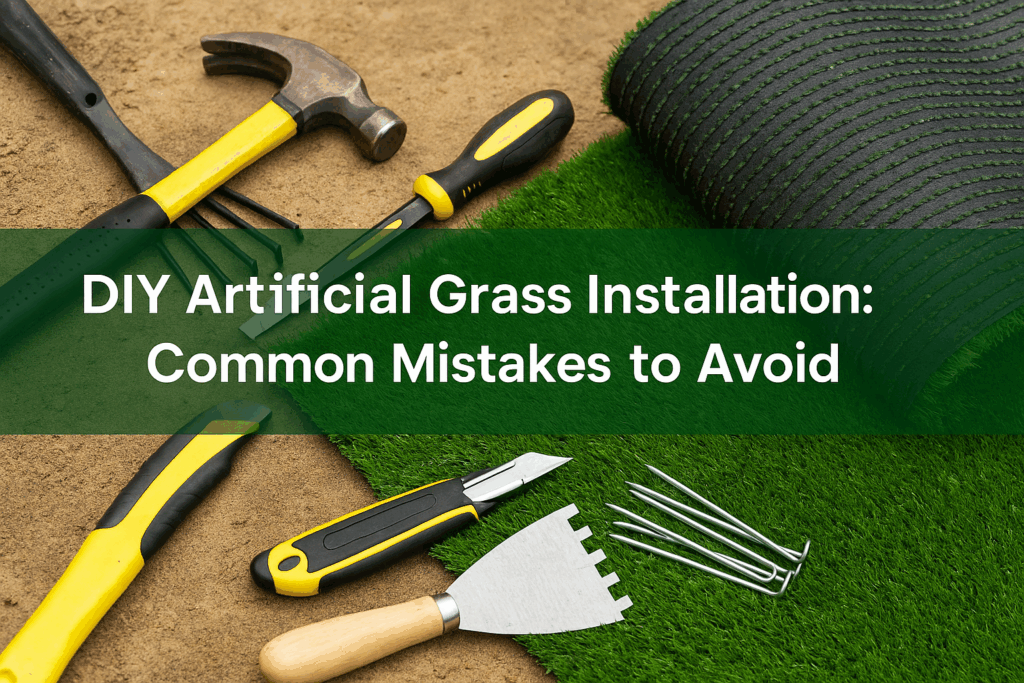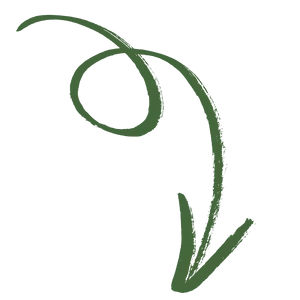Artificial grass is a game-changer for pet owners, offering a durable, low-maintenance solution for outdoor spaces. However, when you have dogs, keeping your synthetic lawn clean and odor-free requires a little extra attention.
Maintaining outdoor artificial grass for dogs is essential to ensuring a clean, safe, and odor-free environment for both pets and families. Without proper care, issues like odor buildup, pet stains, and bacteria growth can reduce its benefits.
This guide will offer practical cleaning tips and best practices to protect your investment, maintain your lawn’s aesthetic appeal, and create a healthier play area for your dogs.
Preview of Key Sections:
- Regular Cleaning to Prevent Odor Buildup
- Managing Pet Waste and Stains
- Addressing Bacteria and Mold Growth
- Maintaining Proper Drainage
- Removing Pet Hair and Debris
- Brushing and Fluffing the Turf to Prevent Flattening
- Choosing Pet-Safe Cleaning Products

Regular Cleaning to Prevent Odor Buildup
One of the most common issues pet owners face is odor buildup, particularly from dog urine. Unlike natural grass, artificial turf doesn’t absorb liquid, raising a common question among pet owners: can dogs pee on artificial grass without causing odors? With regular cleaning, you can prevent foul smells and maintain a fresh-smelling lawn.Â
Best Practices:
- Rinse the turf weekly: Use a garden hose to rinse the area thoroughly, especially in spots where your dog urinates frequently. This simple step prevents urine from accumulating and soaking into the infill, where it can lead to stubborn odors. Regular rinsing ensures that waste is washed away before it has a chance to dry and become embedded in the turf fibers, making deep cleaning less frequent and more effective.
- Use an enzyme-based cleaner: Enzyme-based cleaners are effective at breaking down organic material, eliminating odors rather than masking them. These products contain natural enzymes that target and neutralize odor-causing bacteria, offering a long-lasting solution. Applying the cleaner every few weeks or after heavy use will help maintain a fresh-smelling lawn, even if your pet frequently uses the area.
- Encourage proper drainage: Ensure that your artificial grass has a functioning drainage system to help wash away urine. Good drainage prevents liquid from pooling, which is a common cause of lingering odors and bacteria growth. Regularly inspect the drainage system to make sure there are no blockages, and consider using infill materials designed for optimal water flow.
Tip: If you notice persistent odors despite regular cleaning, consider applying a pet-specific turf deodorizer monthly. These deodorizers work as an extra layer of protection, neutralizing odors on contact and leaving a pleasant scent behind.
The Ultimate Guide to Cleaning Artificial Grass provides expert tips on removing pet waste, preventing odors, and maintaining a clean, durable lawn. It’s a trusted resource for homeowners seeking long-lasting artificial grass care.
To explore additional turf maintenance tips and products specifically for pets, visit our pet-friendly artificial grass solutions.

Managing Pet Waste and Stains
Dog waste can leave behind stains or residue if not cleaned promptly. Regularly managing pet waste ensures that your artificial grass stays clean and maintains its lush, green appearance while preventing long-term damage from embedded waste or bacteria.
Why Proper Management Helps:
- Prevents permanent discoloration and damage to turf fibers.
- Keeps your lawn smelling fresh by avoiding waste buildup.
- Protects your pets and family from exposure to harmful bacteria.
Steps to Clean Pet Waste:
- Remove solid waste immediately: Use a plastic bag or scooper to dispose of feces as soon as possible. This prevents waste from drying and becoming more difficult to clean.
- Rinse the affected area: Spray the area with a garden hose to wash away any residue. A quick rinse ensures that no remnants are left behind to cause odors or stains.
- Use a gentle turf cleaner: Apply a pet-safe cleaning solution to prevent stains or bacteria buildup. Enzyme-based turf cleaners are particularly effective because they break down organic materials like feces, ensuring complete sanitation.
Chemicals and Products to Use:
- Enzyme-based cleaners: These are highly recommended for breaking down organic waste and eliminating odors.
- Pet-safe disinfectants: Choose biodegradable and non-toxic disinfectants to kill bacteria without harming your pet or turf.
- Mild soap and water solution: For light stains, a simple mixture of water and mild soap can effectively clean the area without causing damage.
Tip: For stubborn stains, gently scrub the area with a soft-bristle brush and a mixture of water and mild soap. If the stain persists, consider using a stronger pet-safe cleaner or consult a professional cleaning service.
By properly managing pet waste and using the right products, you can protect your artificial grass from damage while keeping it clean, odor-free, and safe for your pets and family.
The Cleaning Artificial Grass for Dogs blog offers essential tips on maintaining pet-friendly artificial lawns. It covers effective cleaning methods, odor prevention, and proper sanitation to keep your lawn fresh and safe for dogs.
The ASPCA provides advice on safely managing pet waste and preventing odor buildup, ensuring a healthy space for pets.

Addressing Bacteria and Mold Growth
Moisture combined with pet waste can create an ideal environment for bacteria and mold to thrive. Left unchecked, this can pose health risks for both pets and family members, including skin irritations, respiratory issues, and infections.
Taking proactive steps to sanitize your artificial grass helps mitigate these risks, ensuring a clean and healthy environment for everyone.
How Often Should You Sanitize?
- Monthly sanitation: As a general rule, apply a pet-friendly disinfectant at least once a month to keep bacteria and mold under control.
- Bi-weekly sanitation in humid areas: In regions with high humidity or frequent rainfall, you may need to sanitize every two weeks to prevent mold growth.
- After heavy use: If your pets use the lawn daily, especially for bathroom breaks, sanitize it more frequently to maintain hygiene.
Health Benefits of Sanitizing:
- Prevents infections and illnesses: Regular sanitization eliminates harmful bacteria that can cause illnesses in both pets and humans, such as skin infections and gastrointestinal issues.
- Reduces allergic reactions: Mold and bacteria buildup can trigger allergic reactions or respiratory discomfort, particularly in sensitive individuals.
- Keeps your pets safe: By removing harmful pathogens, you protect your pets from skin irritations, paw infections, and exposure to bacteria while they play.
Sanitization Tips:
- Apply disinfectants periodically: Choose a pet-friendly disinfectant and apply it monthly (or more frequently if needed) to kill harmful bacteria.
- Ensure proper airflow: Adequate airflow and sunlight exposure can help naturally reduce mold and bacteria.
- Check drainage systems regularly: Poor drainage can cause water to pool, encouraging bacterial growth and increasing the need for frequent sanitation.
Tip: If you live in a humid area, consider increasing the frequency of sanitization to keep your lawn healthy and mold-free.
The Guide to Mold-Resistant Artificial Grass explains how to prevent mold growth and maintain a clean, healthy lawn. It offers tips on proper drainage, cleaning techniques, and mold-resistant turf options, making it a valuable resource for homeowners.
The CDC highlights the importance of regular sanitization to minimize pet allergens, bacteria, and mold risks in shared spaces.

Maintaining Proper Drainage
Artificial grass for dogs should have a reliable drainage system to prevent standing water and odors. Poor drainage can lead to puddles, which attract bacteria and mold.
Tips to Maintain Good Drainage:
- Clean infill regularly: Remove any debris, pet hair, or leaves that could clog the infill and prevent water from draining efficiently. Use a stiff-bristled brush or a leaf blower to remove debris weekly. Regular cleaning ensures that water flows properly through the drainage system and prevents pooling that can lead to bacterial growth and odors.
- Inspect and repair damaged sections: Any rips, tears, or worn-out sections of artificial turf can disrupt the flow of water and lead to drainage issues. Check your turf periodically for damage, especially after heavy pet activity or severe weather. Repairing or replacing damaged sections promptly will prevent water from accumulating and causing long-term problems.
- Elevate problem areas: If certain areas consistently experience water pooling or slow drainage, consider regrading the ground beneath the turf to improve water flow. You can also add additional drainage layers, such as a gravel base, to help water disperse more effectively. For minor elevation adjustments, adding extra infill material to low spots can help redirect water.
- Ensure proper slope: The underlying surface should have a slight slope to allow water to flow naturally toward drainage points. Check if the slope is maintained and make adjustments as needed to promote better runoff.
Tip: After heavy rainfall or cleaning sessions, inspect the area for any signs of water pooling and address the issue promptly to avoid odors, mold, and damage to the turf.
The Artificial Grass Drainage Problems and Fixes blog covers common drainage issues, their causes, and practical solutions. It provides expert advice on maintaining proper drainage to prevent puddling, mold, and long-term damage to your artificial lawn.
If you’re planning to upgrade or install a system with optimal drainage, check out our DIY artificial grass installation guide or consider our Do-It-For-Me service for professional help.

Removing Pet Hair and Debris
Dogs naturally shed hair, and over time, this can accumulate in your artificial grass, reducing its appearance and potentially blocking drainage.
Pet hair, dirt, and other debris can also create breeding grounds for bacteria if not managed properly, making it crucial to stay on top of maintenance.
Why Regular Debris Removal Is Important:
- Prevents clogged drainage: Excessive buildup of pet hair and debris can block the infill, preventing proper water drainage and leading to puddles or standing water.
- Maintains the lawn’s appearance: Regular removal of pet hair keeps the artificial grass looking neat, clean, and well-maintained.
- Reduces bacterial growth: Cleaning debris minimizes the accumulation of organic material that could foster bacteria or unpleasant odors.
Simple Steps to Remove Pet Hair:
- Brush regularly: Use a stiff broom or turf rake to brush away pet hair and prevent buildup. Brushing also helps keep the turf fibers upright, contributing to its natural look.
- Use a leaf blower: A leaf blower can quickly and efficiently remove loose hair, leaves, and other debris, making this method ideal for large areas.
- Vacuum with care: For stubborn pet hair that brushes and blowers may miss, use a vacuum with a gentle setting. Be cautious not to damage the turf by using a vacuum that is too powerful.
Additional Tips:
- Incorporate brushing into a weekly routine: Regular maintenance ensures debris doesn’t accumulate to the point of causing drainage or aesthetic issues.
- Clean after high-shedding periods: Dogs shed more during certain seasons, so increase cleaning frequency during those times.
- Brush your dog regularly: Keeping your dog’s coat groomed reduces overall shedding, helping minimize hair buildup on the lawn.
By incorporating these steps into your maintenance routine, you can extend the life of your artificial grass, preserve its aesthetic appeal, and provide a clean, enjoyable space for your pets to play.

Brushing and Fluffing the Turf to Prevent Flattening
Active dogs can cause artificial grass to flatten over time, especially in high-traffic areas. Regular brushing helps keep the turf looking natural and prevents wear.
Brushing Tips:
- Brush the grass monthly: Use a stiff-bristled brush or broom to fluff up flattened areas.
- Focus on high-traffic spots: Areas where your dog plays frequently may need extra attention.
- Brush in multiple directions: This helps restore the blades to their original upright position and ensures an even appearance.
Tip: Avoid using metal rakes, as they can damage the turf fibers.

Choosing Pet-Safe Cleaning Products
Using the wrong cleaning products can damage your artificial grass and potentially harm your pets. Always opt for pet-safe options.
For access to premium cleaning supplies and artificial turf maintenance kits, explore our outdoor living solutions.
What to Look For in Cleaning Products:
- Non-toxic and biodegradable: Ensure the product is safe for pets and environmentally friendly. Non-toxic products minimize the risk of harmful exposure to chemicals for both pets and humans, and biodegradable options are eco-friendly, breaking down naturally without harming the environment.
- Enzyme-based cleaners: These break down organic matter and help eliminate pet-related odors effectively. Enzyme-based cleaners work by targeting and neutralizing the compounds found in pet waste, such as urine and feces, that cause unpleasant odors. They provide a deep clean by breaking down stubborn organic buildup, which can otherwise lead to long-term odor problems.
- Avoid harsh chemicals: Bleach and other harsh chemicals can degrade the turf’s material over time. Harsh chemicals may cause the turf fibers to weaken, fade, or become brittle, shortening the lifespan of your artificial grass. Additionally, these chemicals can pose health risks to pets, such as skin irritation or gastrointestinal issues if ingested. Choosing mild, pet-safe alternatives ensures both durability and safety.
Tip: Look for products labeled as “pet-safe” and test any new cleaning product on a small patch of grass before applying it to larger areas to ensure no adverse effects.
Final Thoughts: Keep Your Outdoor Artificial Grass Looking Great
Maintaining outdoor artificial grass for dogs doesn’t have to be overwhelming. By following these cleaning tips and best practices—from regular rinsing and waste removal to brushing and using pet-safe products—you can keep your artificial lawn looking fresh, clean, and odor-free.
Protect your investment and give your dogs a comfortable, healthy play area with proper maintenance.
If you need assistance with artificial grass products, installation, or maintenance, Buy-Grass is here to help.
Contact us today for expert guidance on all your outdoor artificial grass for dogs and landscaping solutions.

